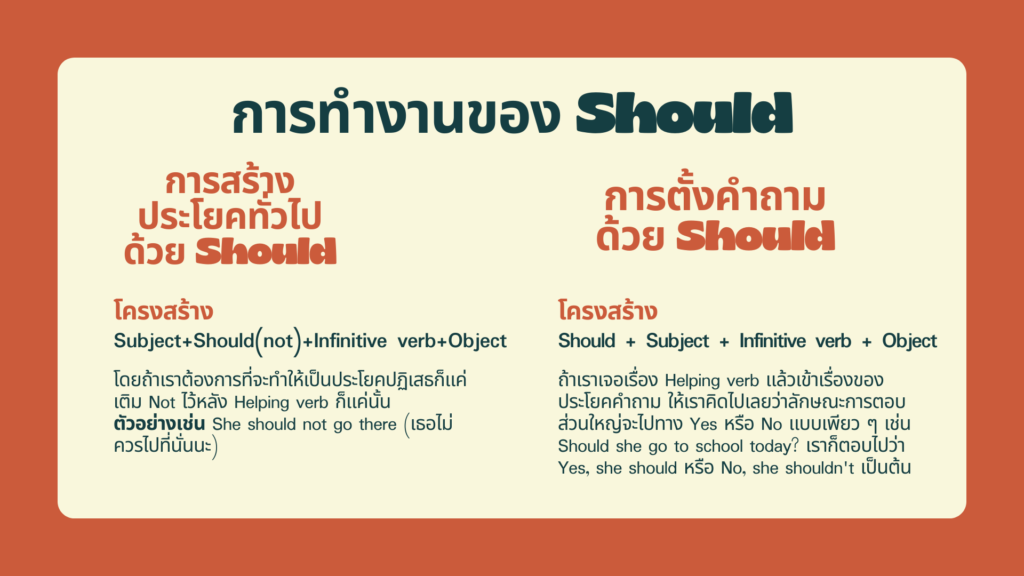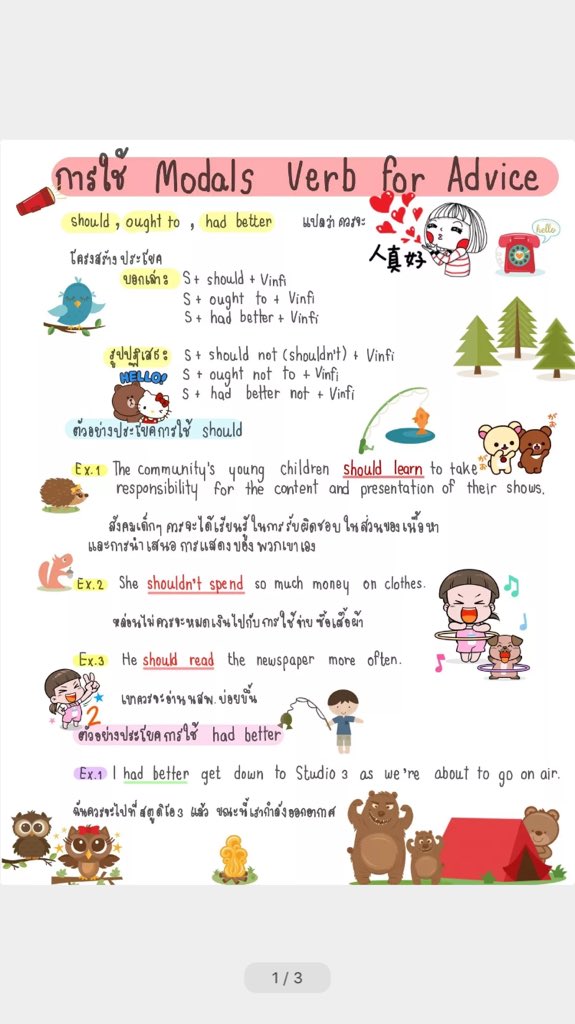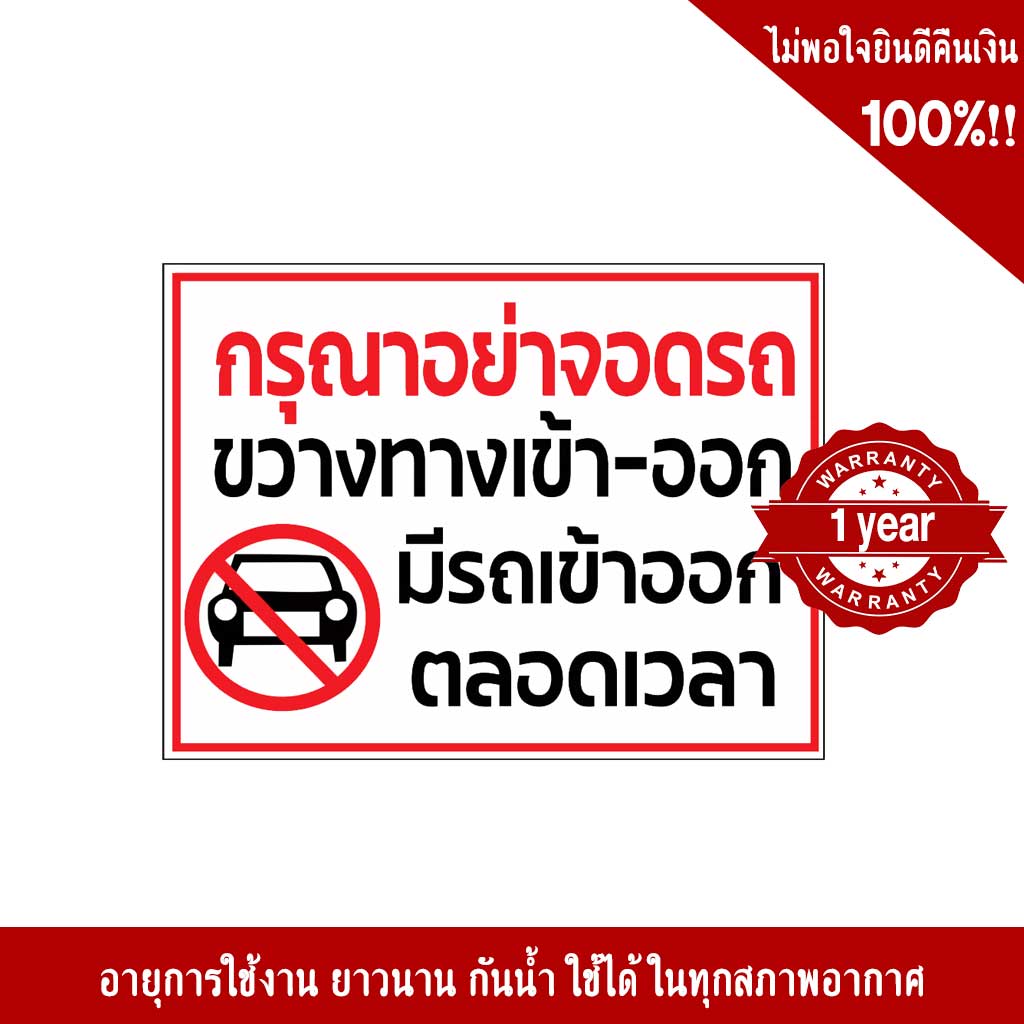การใช้ Not
1. การใช้ Not เป็นคำแสดงถึงการปฏิเสธหรือเป็นการประกาศของสภาวะที่ขัดแย้งกับสถานภาพปกติ
Not ใช้เพื่อแสดงถึงการปฏิเสธหรือให้ข้อมูลเกี่ยวกับสภาวะที่ขัดแย้งกับสถานภาพปกติ ตัวอย่างเช่น “ไม่ไปที่งานเลย” หรือ “ไม่ดีเลย” เป็นต้น ในบางกรณี not ยังสามารถใช้เพื่อแสดงความเสียใจหรือความไม่พอใจเช่นกัน เช่น “ไม่เก่งเลย” หรือ “ไม่ดีต่อใจ”
2. การใช้ Not เพื่อแสดงความเข้าใจทางปฏิสัมพันธ์และการระบายความคิดเห็น
Not สามารถใช้เพื่อแสดงความเข้าใจทางปฏิสัมพันธ์และการระบายความคิดเห็นได้ด้วย เช่น “ไม่เข้าใจเรื่องที่คุณพูด” หรือ “ไม่เห็นด้วยกับความคิดของคุณ”
3. การใช้ Not เพื่อเป็นตัวดปฏิเสธหรือยกเว้นสิ่งใดสิ่งหนึ่ง
Not สามารถใช้เพื่อเป็นตัวอธิบายการปฏิเสธหรือยกเว้นสิ่งใดสิ่งหนึ่งได้ เช่น “ไม่ดื่มแอลกอฮอล์” หรือ “ไม่ส่งจดหมาย”
4. การใช้ Not เพื่อแสดงการเปลี่ยนแปลงสถานะ
Not สามารถใช้เพื่อแสดงการเปลี่ยนแปลงสถานะได้ เช่น “ไม่อยู่บ้าน” หรือ “ไม่มีเงิน”
5. การใช้ Not เพื่อแสดงการปฏิเสธหรือยกเลิกการกระทำ
Not สามารถใช้เพื่อแสดงการปฏิเสธหรือยกเลิกการกระทำได้ เช่น “ไม่รับงานนี้” หรือ “ไม่ต้องการอาหาร”
6. การใช้ Not เพื่อคำแสดงสถานะที่น่าพิศวงอย่างไม่น่าเชื่อถือ
Not สามารถใช้เพื่อแสดงสถานะที่น่าพิศวงและไม่น่าเชื่อถือ เช่น “ไม่ซื่อสัตย์” หรือ “ไม่เกียจคร้าน”
7. การใช้ Not เพื่อแสดงการเปลี่ยนแปลงของปริมาณหรือค่าต่างๆ
Not สามารถใช้เพื่อแสดงการเปลี่ยนแปลงของปริมาณหรือค่าต่างๆ เช่น “ไม่มีคน” หรือ “ไม่มีเงิน”
8. การใช้ Not เพื่อกรองหรือเลือกตั้งค่าที่ไม่ตรงกับเงื่อนไขหรือรูปแบบที่กำหนด
Not สามารถใช้เพื่อกรองหรือเลือกตั้งค่าที่ไม่ตรงกับเงื่อนไขหรือรูปแบบที่กำหนด เช่น “ไม่ใช่สีที่ต้องการ” หรือ “ไม่ใช่ค่าที่ถูกต้อง”
9. การใช้ Not เพื่อเปลี่ยนแปลงความหมายของคำ หรือการเป็นคำกริยา
Not สามารถใช้เพื่อเปลี่ยนแปลงความหมายของคำหรือการเป็นคำกริยาได้ เช่น “ไม่ได้ยิน” หรือ “ไม่เข้าใจ”
การใช้ Not เป็นหนึ่งในวิธีการสื่อสารที่สำคัญในภาษาไทย โดยสามารถแสดงความเห็นหรือปรึกษาถึงสถานการณ์หรืออธิบายการปฏิเสธหรือขัดแย้งสถานภาพปกติได้เป็นอย่างดี นอกจากนี้ยังสามารถใช้เพื่อเปลี่ยนแปลงสถานะหรือข้อมูลต่างๆ และเปลี่ยนแปลงความหมายของคำหรือการเป็นคำกริยาได้อีกด้วย
FAQs:
Q: Is not อ่านว่าอย่างไรในภาษาไทย?
A: ในภาษาไทยเราอ่าน not ว่า “นอต”
Q: ใช้ not เพื่อแสดงถึงอะไรเป็นอย่างไร?
A: not สามารถใช้แสดงถึงการปฏิเสธหรือประกาศของสภาวะที่ขัดแย้งกับสถานภาพปกติ แสดงความเสียใจหรือความไม่พอใจ หรือเป็นตัวอธิบายการปฏิเสธหรือยกเว้นสิ่งใดสิ่งหนึ่งได้
Q: การใช้ not อย่างไรจะถูกต้อง?
A: เพื่อให้การใช้ not ถูกต้องควรปฏิบัติตามกฎเกณฑ์ของภาษาไทย และควรใช้ในบริบทที่เหมาะสมเพื่อให้คำสื่อความหมายที่ชัดเจน และสื่อถึงวัตถุประสงค์ให้เข้าใจถูกต้อง
Q: ใช้ not แทนคำอื่นได้หรือไม่?
A: ใช้ not เป็นคำแสดงปฏิเสธหรือประกาศสภาวะที่ขัดแย้งกับสถานภาพปกติได้ แต่บางครั้งอาจมีคำอื่นที่มีความหมายใกล้เคียงกัน แต่อย่างไรก็ตามการใช้ not เป็นที่นิยมและเป็นที่รับรู้กันมากที่สุดในภาษาไทย
Q: การใช้ not ในภาษาไทยคล้ายกับการใช้ not ในภาษาอังกฤษหรือไม่?
A: not ในภาษาไทยและภาษาอังกฤษมีความหมายใกล้เคียงกัน แต่การใช้ not ในภาษาไทยมีลักษณะที่สำคัญและมีความหลากหลายกว่าในภาษาอังกฤษ
Q: สำหรับคำสื่อความหมายใกล้เคียงกับ not ในภาษาไทยมีอะไรบ้าง?
A: มีคำอื่นที่สามารถใช้แทน not ได้บางคำ เช่น ไม่, ห้าม, เป็นอันขาด ขึ้นอยู่กับบริบทและความเหมาะสมของประโยคที่ต้องการสื่อความหมาย
No กับ Not มีวิธีใช้ต่างกันยังไง? (เข้าใจง่ายมาก) I Krupann Official
คำสำคัญที่ผู้ใช้ค้นหา: การใช้ not Is not, no ตามด้วย noun, Do not, การใช้ to, Not be คือ, ไม่ใช้ ภาษาอังกฤษ, not อ่านว่า, Are not
รูปภาพที่เกี่ยวข้องกับหัวข้อ การใช้ not

หมวดหมู่: Top 21 การใช้ Not
ดูเพิ่มเติมที่นี่: lasbeautyvn.com
Is Not
When it comes to learning a new language, one of the most important aspects is understanding how to form negative sentences. In Thai, the phrase “is not” is an essential part of everyday communication. In this article, we will delve into the intricacies of expressing negation in the Thai language, exploring different forms, rules, and common usage.
Forming Negation in Thai:
In Thai, the phrase “is not” is typically expressed using the word ไม่ (mâi). This word is used to form negative sentences by placing it before the main verb or adjective. Here are a few examples:
1. ฉันไม่กิน (chăn mâi gin) – I don’t eat
2. เขาไม่เขียน (khăo mâi khian) – He doesn’t write
3. เราไม่อยู่ (rao mâi yùu) – We’re not here
As seen in the examples above, the word ไม่ (mâi) directly negates the verb following it. It’s essential to remember its placement; if it is placed incorrectly, it can alter the meaning of the sentence.
Negating Adjectives and Possession:
In addition to negating verbs, Thai also allows the negation of adjectives and possession. To form negative expressions with adjectives, simply place ไม่ (mâi) before the adjective. For example:
1. เขาไม่สวย (khăo mâi suay) – She is not beautiful
2. ชื่อห้องนี้ไม่ใหญ่ (chûue hông née mâi yài) – This room is not big
Similarly, when negating possession, use the structure ไม่มี (mâi mii). Here are a couple of examples:
1. เขาไม่มีรถ (khăo mâi mii rót) – He does not have a car
2. ฉันไม่มีเงิน (chăn mâi mii ngern) – I don’t have money
Common Usage and Exceptions:
While the general rule of using ไม่ (mâi) before the verb, adjective, or possession applies to most scenarios, there are a few exceptions worth mentioning. One notable exception is when negating the verb “to be” which is คือ (khue). Instead of using ไม่ (mâi), Thai employs the word ไม่ใช่ (mâi châi). Consider the following examples:
1. เขาไม่ใช่คนไทย (khăo mâi châi khon thai) – He is not Thai
2. มันไม่ใช่นก (man mâi châi nók) – It is not a bird
Furthermore, when negating action verbs that imply a future event or a request, Thai uses the word ไม่ (mâi) in combination with เป็น (bpen) or จะ (jà). Here are some examples:
1. เราไม่เป็นไป (rao mâi bpen bpai) – We are not going
2. คุณไม่จะทำหน้าที่ (kun mâi jà tham nâa thîi) – You will not do the duty
FAQs:
Q: Is it necessary to always use ไม่ (mâi) to form negative sentences?
A: Yes, for most verb, adjective, and possession negations, the word ไม่ (mâi) is crucial to create a negative expression.
Q: Are there any exceptions to the usage of ไม่ (mâi)?
A: Yes, when negating the verb “to be”, Thai uses the word ไม่ใช่ (mâi châi). Additionally, when negating future events or requests, ไม่ (mâi) is combined with เป็น (bpen) or จะ (jà).
Q: Can I use ไม่ (mâi) with any adjective?
A: Yes, you can use ไม่ (mâi) with any adjective to form a negative expression. Simply place it before the adjective in question.
Q: How do I negate possession in Thai?
A: To negate possession, use the structure ไม่มี (mâi mii) before the object being possessed.
Q: How can I say “there is not” or “there are not” in Thai?
A: To express negation with “there is” or “there are,” use ไม่มี (mâi mii) followed by the noun or object in question. For instance, หนังสือไม่มี (năng seu mâi mii) means “There are no books.”
Q: Can I omit ไม่ (mâi) in negative sentences?
A: No, omitting ไม่ (mâi) in negative sentences would drastically alter the meaning of the sentence. It is essential to include it to indicate negation.
In conclusion, understanding how to form negative sentences in Thai is vital for effective communication. By leveraging the word ไม่ (mâi) and placing it correctly before verbs, adjectives, or possession, one can confidently express negation. Keep in mind the exceptions discussed and practice using negative expressions to enhance your Thai language skills.
No ตามด้วย Noun
Formation and Usage:
The structure of no ตามด้วย noun is relatively straightforward. It consists of the word “no” (pronounced “mai”) followed by the preposition ตาม (pronounced “dtam”) and a noun. The noun that follows can be either a common noun or a proper noun.
This construction is used to negate the possession or ownership of the noun that follows. It is important to note that this structure cannot be used to negate the possession of personal pronouns like “I,” “you,” “he,” or “she.” However, it is commonly used with common nouns, proper nouns, or inanimate objects.
Examples:
1. ผมไม่มีเงิน (Pom mai mee ngern) – I don’t have money.
2. เขาไม่มีรถ (Kao mai mee rot) – He doesn’t have a car.
3. เธอไม่มีเวลา (Ter mai mee wayla) – She doesn’t have time.
4. พ่อของฉันไม่มีบ้าน (Phor kong chan mai mee ban) – My father doesn’t have a house.
5. ทีมฟุตบอลไม่มีแฟนคลับ (Team futbol mai mee fanclub) – The football team doesn’t have a fan club.
As evidenced by the examples above, no ตามด้วย noun is a commonly used construction in Thai. It allows for concise expression of the lack of possession of the noun that follows, making it an essential tool in daily communication.
FAQs Section:
Q1. Can the no ตามด้วย noun structure be used with personal pronouns?
A1. No, this construction cannot be used to negate the possession of personal pronouns like “I,” “you,” “he,” or “she.” It is intended for use with common nouns, proper nouns, or inanimate objects.
Q2. Are there any other ways to express negation in Thai?
A2. Yes, there are several other ways to express negation in Thai. One common method is by using the word “mai” before the verb. For example, “I don’t eat” is expressed as “ผมไม่กิน” (Pom mai gin). Another method is by using the word “mai” after the verb to create a negative command. For example, “Don’t go” is expressed as “อย่าไป” (Ya pai) or “ไม่ไป” (Mai pai). Additionally, negative particles like “mai chai” or “mai roo” can be used to express negation in certain contexts.
Q3. Are there any exceptions to using the no ตามด้วย noun structure?
A3. Yes, there are a few exceptions to using this structure. It is typically used to express possession or ownership. However, it is not commonly used to express negation of attributes or characteristics. In such cases, other structures or expressions may be more appropriate.
Q4. Can the no ตามด้วย noun structure be used in formal or written Thai?
A4. Yes, this structure is widely used in both formal and written Thai. It is considered a standard grammatical construct and is commonly found in formal documents, literature, and everyday conversation.
In conclusion, the no ตามด้วย noun structure is a vital part of the Thai language, allowing for concise negation or denial of possession. Its formation and usage are relatively straightforward, making it an essential tool in Thai communication. By understanding and applying this structure correctly, learners of Thai can enhance their language proficiency and engage in more nuanced conversations.
มี 45 ภาพที่เกี่ยวข้องกับหัวข้อ การใช้ not.








![คลังภาษาอังกฤษ] ⚠️วลีที่เป็นทางการและไม่เป็นทางการ⚠️ [Useful Formal and Informal Phrases in English] ✓ ในการเขียนแต่ละประเภท อาทิ การเขียนจดหมายธุรกิจ การเขียนบทความวิชาการ บทคัดย่อ การเขียนย่อหน้า การเขียนทั่วไป และ คลังภาษาอังกฤษ] ⚠️วลีที่เป็นทางการและไม่เป็นทางการ⚠️ [Useful Formal And Informal Phrases In English] ✓ ในการเขียนแต่ละประเภท อาทิ การเขียนจดหมายธุรกิจ การเขียนบทความวิชาการ บทคัดย่อ การเขียนย่อหน้า การเขียนทั่วไป และ](https://t1.blockdit.com/photos/2020/04/5ea04eeade10771c0121fc86_800x0xcover_IiSHYKSW.jpg)

ลิงค์บทความ: การใช้ not.
ดูข้อมูลเพิ่มเติมเกี่ยวกับโพสต์หัวข้อนี้ การใช้ not.
- No กับ Not ใช้ต่างกันอย่างไร | Wall Street English Thailand
- Grammar: ความแตกต่างระหว่าง No กับ Not ใช้ต่างกันอย่างไร
- วิธีใช้ No กับ Not ในภาษาอังกฤษ ความเหมือนที่แตกต่าง ลองดูว่าเป็น …
- No และ Not ใช้ต่างกันอย่างไร โครงสร้างการใช้ ตัวอย่างประโยค ความ …
- No กับ Not ต่างกันอย่างไร ? – Engnow.in.th เรียนภาษาอังกฤษ …
- 3 ขั้นตอนสู่การใช้ “not” และ “no” อย่างแม่นยำ – Today’s English …
ดูเพิ่มเติม: blog https://lasbeautyvn.com/category/digital-studios